When you hear the word “bees,” what do you think of? Being stung (ouch!), the taste of delicious honey, or maybe a low, steady buzzing sound? There are quite a few types of bees out there, and they all play an important role in our environment. In this post, we’ll talk bee types and bee hive hierarchy and look at the bees’ meaner cousins, the wasps.
Bees are the world’s greatest pollinators, and they do that big time. They help with the pollination of one-third of the food we consume.
They are also a massive part of our global economy. Without them, we would bee in big trouble.
But bees are not all alike. To truly understand these wonderful little creatures, we need to distinguish between the most common types of bees.
All Types of Bees
There are around 20,000 known species of bees. Antarctica is the only continent without a bee population. There are over 4,000 species in North America alone.
Regardless of location, bee types usually fall into one of two major classifications: social bees and solitary bees.
Social Bees
Social bees are what most people think of when they hear the word “bee.” Social bees have made their way into television, film, and literature.
Winnie the Pooh loved them since they created his favorite snack. There’s even a whole story surrounding if “bees were bears.”
These bees create large gatherings or colonies. Social bee hives have many bees and each bee has many jobs such as producing combs, nourishing their larvae, and making honey.
These “overachievers” are the most likely to be seen generating hives or functioning together to create a community. If you take up beekeeping, you will be dealing with social bees and a number of bees houses.
Good to know: In general, social bees are docile and only sting when they feel that their colony or hive is under threat.
1. Bumble Bees
Bumble Bees (also known as “big bees”) are the hairy pollinators of all kinds of plants and flowers in the garden. They owe their efficiency at pollination in part to their furry coats.
Did you know: Bumble Bees are quite large in size and second only to honey bees in terms of pollination. They leech onto flowers when finding pollen and nectar.

Unfortunately, over 1/5 of all Bumble Bee populations have disappeared because of pesticides and climate change. Competition from honey bees is another problem for these bees.
2. Honey Bees
Another top pollinator, Honey Bees are vital in our ecosystem. They make colonies that can be as huge as 80,000 individual insects. They exist in hives and produce honey.
Honey Bees are not as furry or hairy as Bumble Bees. They’re also smaller in size than the Bumble Bees and have lengthier but narrower figures.

In addition, these bees have groups that labor in a caste system and follow roles in maintaining the hive.
Important: The three castes include the queen bee, the worker bees, and the drones.
What amazes us about these creatures is the amount of work it takes for them to make just one pound of honey. This production requires each bee to fly at least 90,000 miles (think three trips around the globe.) Talk about work ethic!
We’ll talk more about the types of bees in a Honey Bee hive in a bit.
3. Africanized Bees
Africanized Bees are also called “killer bees.” They were being bred with common honey bees to be a new cross-bred when they ran away from a lab in South America.
They are notorious for having a rather wicked temper. They dominate areas once occupied by honey bees and may attack anything or anyone that comes near them.
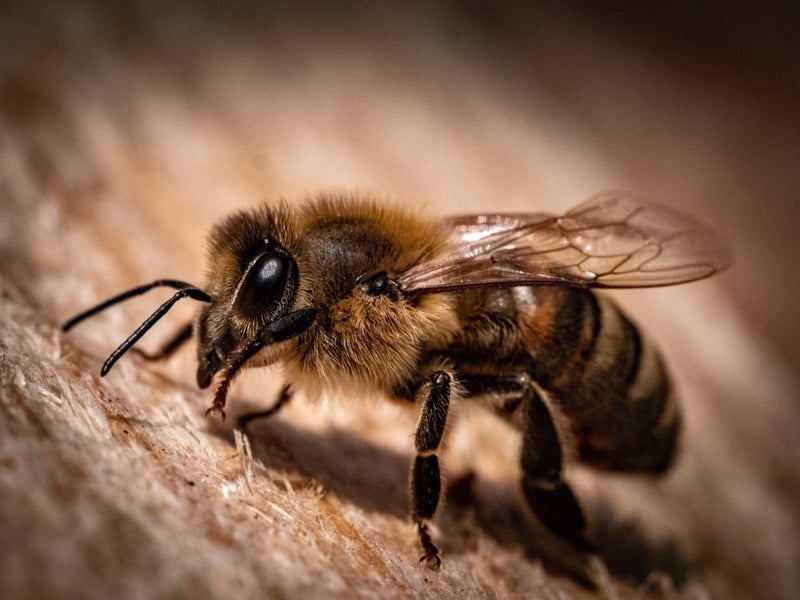
Although they are dangerous and prone to attack at random, they are smaller than honey bees and not as lethal as one might think. And then maybe you also have a bee suit?
Tip: The best way to survive an angry killer bee swarm? Run as fast as you can, protect your head, and seek shelter immediately.
Solitary Bees
These kinds of bees don’t swarm, live alone, and work on their own or in very small groups. Moreover, solitary bees have tiny nests, fly solo, and produce enough food just to feed the larva they have.
Most of them are fairly harmless. Think of them as the introverts who prefer staying home alone with a book rather than partying with friends (unlike social bees).
4. Carpenter Bees
The Carpenter Bee is one such introvert. It looks like a huge, tubby, and extremely hairy Bumble Bee.
However, there are differences between Carpenter Bees and Bumble Bees. These bees are blue-black, unlike the striped Bumble Bees.
Why do we call them Carpenter Bees? Because they create their nests inside wooden nooks, trees, or logs, including wooden benches or wooden shelves.
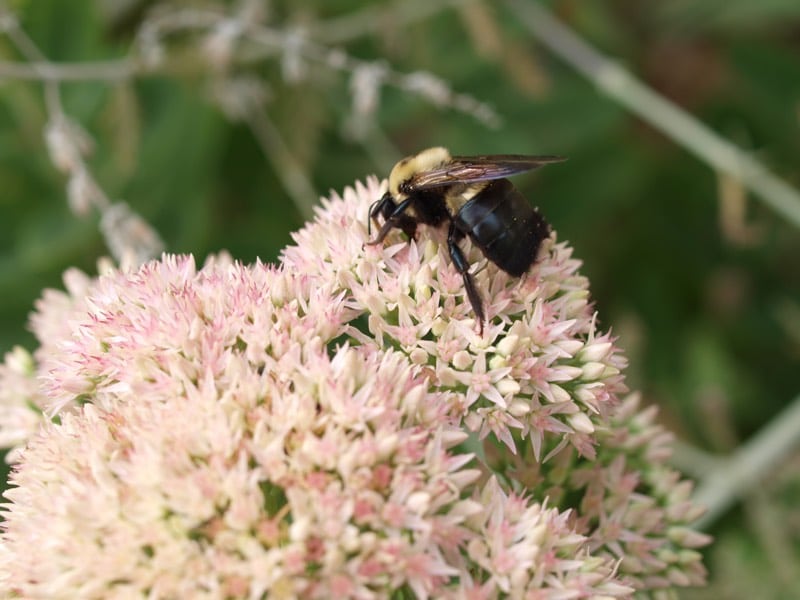
This may seem like no big deal, however, it can become a problem for humans when they start to set up their colonies inside our homes.
Important: A Carpenter Bee can make a hideaway into the wood as chambers for larvae and eggs. It can deteriorate wooden structures and eventually cause destruction to buildings.
In terms of stings, Carpenter Bees are not that aggressive. Male Carpenter Bees do not have stingers. However, female Carpenter Bees do have a stinger that they will use to defend their nests if necessary.
Tip: Want to discourage Carpenter Bees from setting up shop around your wooden structures? Try painting and pressure-washing wooden surfaces.
5. Digger Bees
Usually smaller than Carpenter Bees, Digger Bees are also hairy. In terms of length, they are generally about 12 to 18mm. They are often seen getting out of holes in the ground where they nest.
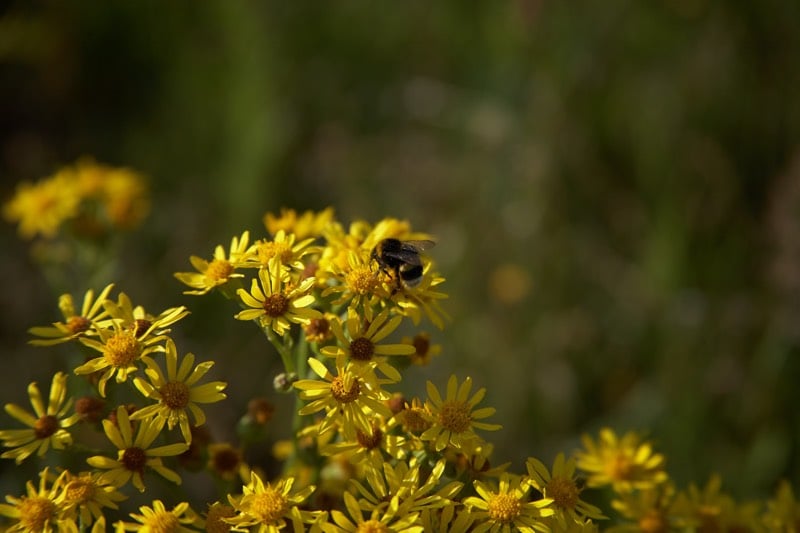
Diggers will make a hideout and guard it. Their tunnels usually comprise of one major hollow and some smaller storage tunnels and for their food, eggs, and larvae.
Fortunately, there is very little danger of being stung by a Digger Bee.
6. Mining Bees
In the Andrena family, there is an estimate of 1200 species of bees, widely known as Mining Bees. They have a similar behavior as Digger Bees.
Mining Bees make tunnels and nests that are intricate underground. Occasionally, mining bees’ offspring set up their chambers nearby on the ground.
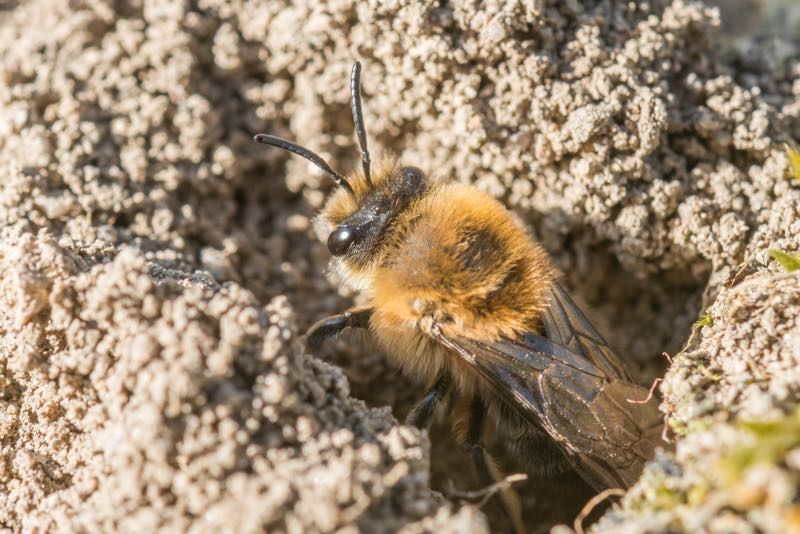
The underground nests they build are similar to housing units with each little bee having its own apartment of sorts. Like most Solitary Bees, the risk of Mining Bees stings is marginal. They are harmless to us and shouldn’t be harmed.
7. Leafcutter Bees
This type of bee measures about 7 to 18mm in length. Leafcutter Bees are very dark and look like they are made from iron.
Leafcutting and Mason bees belong to the same family, but Leafcutter Bees create their tunnels and nests in decaying wood and in buildings’ insulated panels.
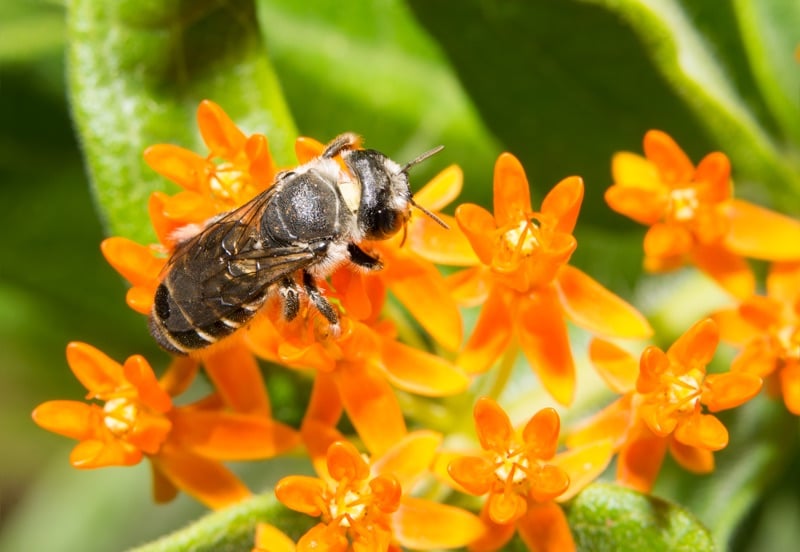
At a distance from buildings, these types of bees will use deep spaces in timeworn trees and logs.
Fun fact: Their name comes from their inclination to cut small pieces off of plants and use them to mark their tunnels.
8. Mason Bees
Mason Bees share many similarities with leafcutters, except that they burrow into soft cement in buildings. Since the holes they make are pretty small, these bees don’t create much damage and won’t upset your garden.
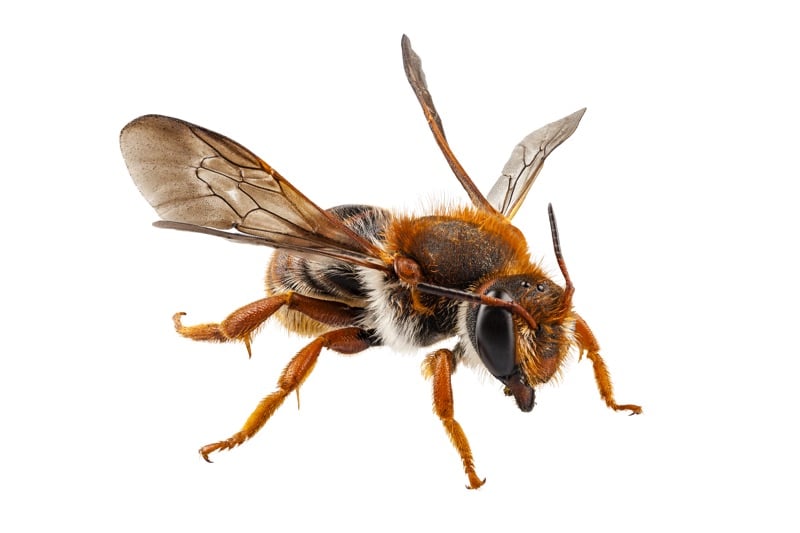
Similar to most solitary bees, there is little threat of being stung by a leafcutting or mason bee.
9. Sweat Bees
If you are out on a hot summer day and encounter a bee, most likely it’s a sweat bee. These are also known as Alkali Bees. These bees can be as small as 3mm in length.
Just like other solitary bees, they like to build their nests in a covert way. Sweat bees are fascinated by the perspiration of humans and other animals. This is why they feel attracted to you!
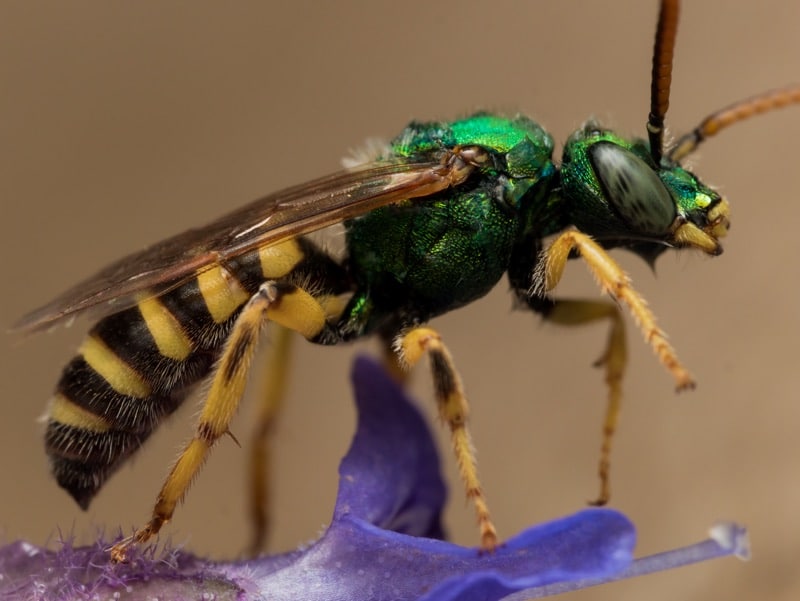
Nonetheless, they are so small that getting stung by them is rare. They are not aggressive and will only sting if pressed against the skin. In other words, you’re looking at one of the more peaceful types of bees.
10. Plasterer Bees
Just a little larger than sweat bees, plasterer bees are 10 to 18mm in length and fairly hairy-looking. They also burrow underground, but will also use cracks in stone and bricks to make their nests.
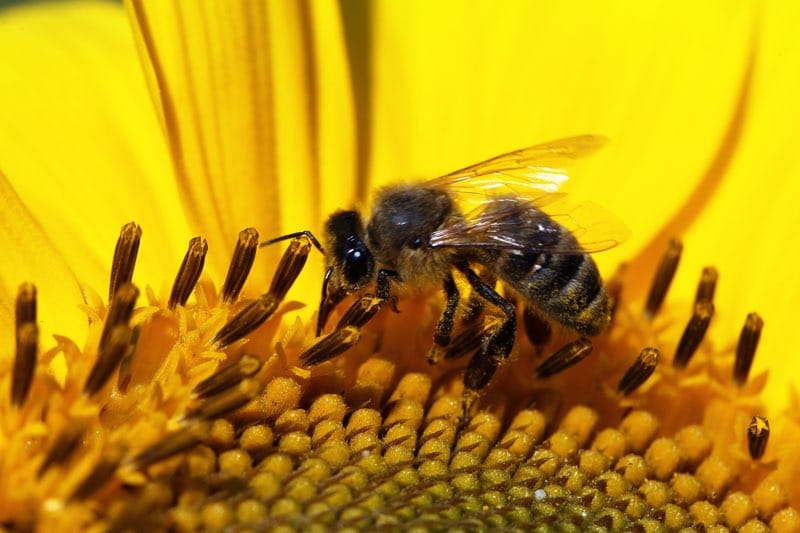
Did you know: We call them Plaster Bees because they plaster the walls of their nests with a discharge that will dry to a lustrous, transparent appearance.
11. Yellow-Faced Bees
How vicious do these guys look? Thank goodness these bees are much more docile than they appear. Yellow-Faced Bees hail from the same family as Plasterer Bees and are usually not bigger than 6mm.
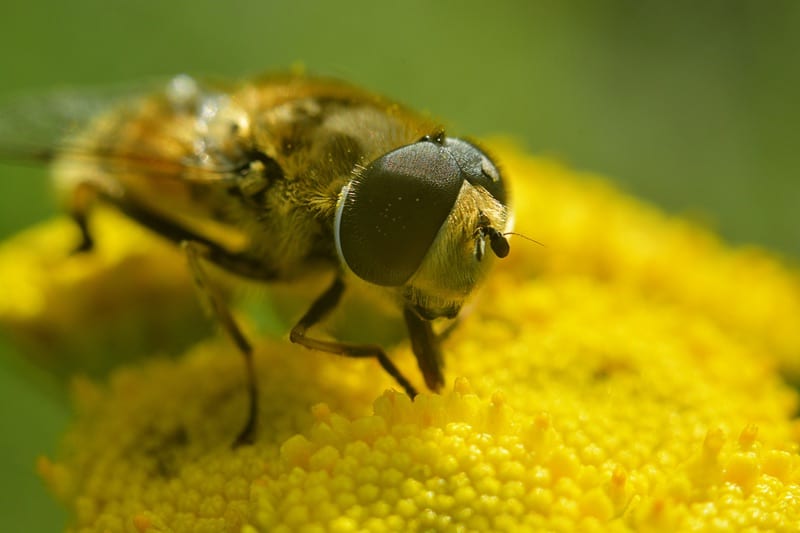
They get their name from their yellow-colored faces, though sometimes they are white. There are over 60 different types of yellow-faced bees in Hawaii alone.
Fact: These bees are known for their elaborate mating rituals.
Types of Bees in a Beehive Explained
Honeybees create a wonderful, structured community that is crucial and helpful to our food chain. Normally, they thrive in colonies that comprise of a queen, drones, and about 20,000 to 80,000 female worker bees.
A bee colony is highly specialized and no bee is able to survive on their own. Hence, every bee must fulfill its own duties and co-operate in order to survive.
In the following list, we’ll give you a quick overview of the types of bees in a beehive and their roles.
1. Queen Bee
The Queen Bee is the largest and longest-surviving kind of bee (she can live for five to six years, and in the bee world, that’s a lot). She is the only sexually developed adult female bee of a colony.
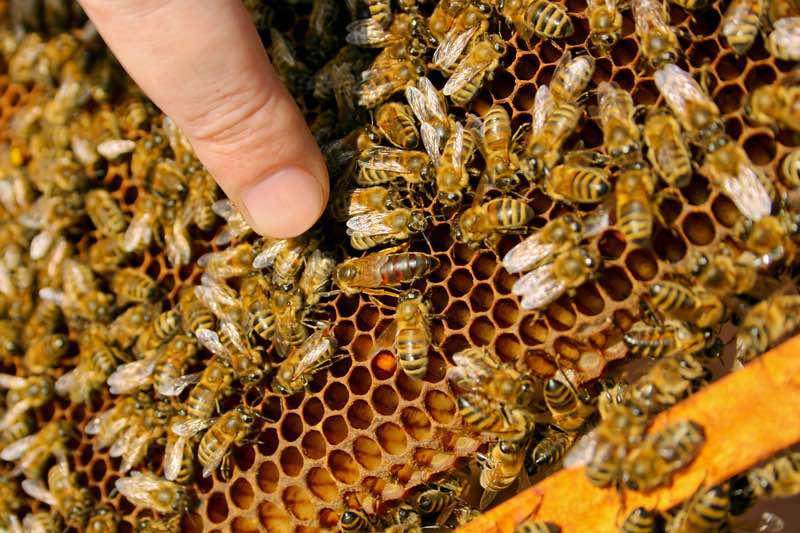
Fact: The queen bee is capable of laying enough fertilized eggs in just one day for the next generation of bees. That’s actually up to 2,000 eggs in a day!
Furthermore, she also releases chemicals that have an influence on other types of bees. The role of the queen bee is vital to maintaining a harmonious work cycle in a beehive.
2. Drone Bees
Drone Bees are male bees whose tasks are easier than worker bees and queen bees. These types of bees only have to eat and mate with the queen bee. Talk about living the life of a king!
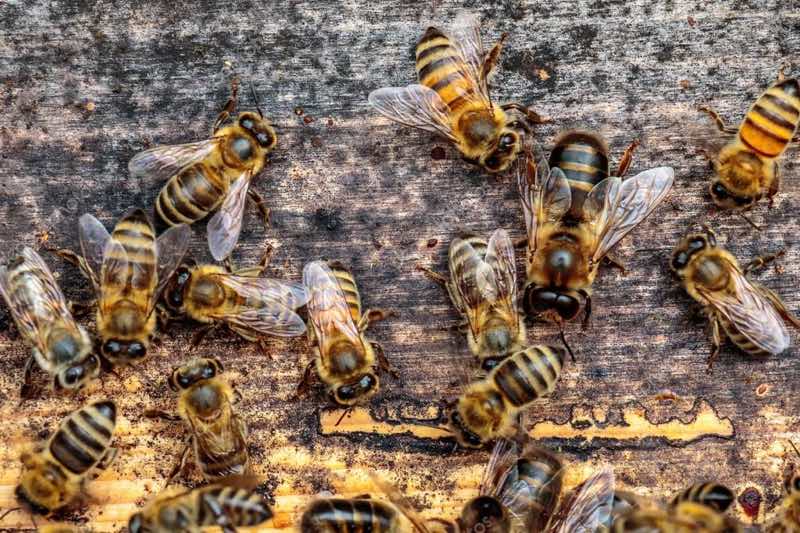
In terms of size, they are bigger than the worker bees but smaller than the queen bee. In spring and summer, hundreds of drone bees live in the hive. Although they seem to have it made, drones actually die after mating with the Queen Bee.
The ones that survive without an encounter are expelled from the hive by the worker bees before winter comes.
3. Worker Bees
In the caste system of a hive, the Worker Bees are all female bees that hunt for food, develop the hive, guard the hive, and maintain the cleanliness of the air within the hive.
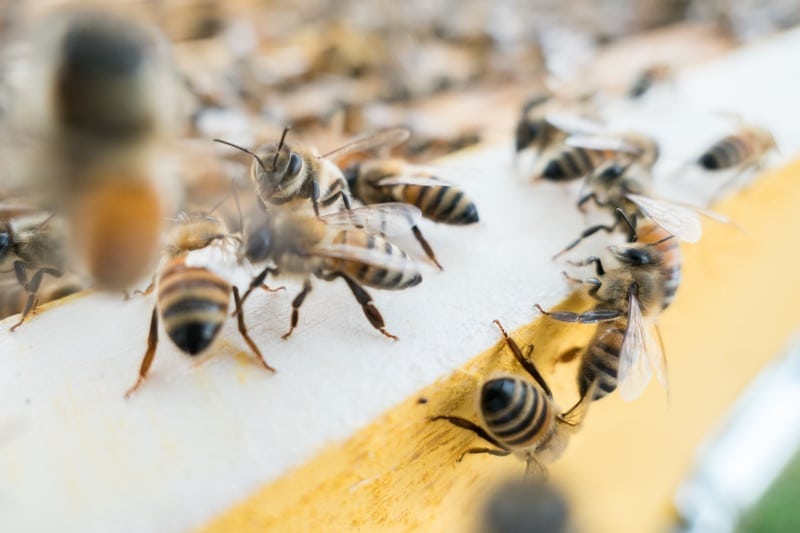
Unlike the other two types of bees, Worker Bees are not capable of laying eggs and are sexually undeveloped. In case you see a bee outside a hive, it’s a worker bee since other bees do not go outside. These ladies are the backbone of all that goes on within.
All Different Types of Wasps
We’ve talked about the different types of bees, now let’s talk about wasps. Why? Because people often confuse wasps with bees. Find out more about bees vs wasps here and the different types of wasps in this article.
When you zoom in on them, though, you can see the difference. There are about 75,000 species of wasps all over the world.
The major difference is that while bees are nectar-drinking insects, wasps are carnivorous flying creatures that prey on other insects like spiders.
The bees are your vegans while the wasps like a nice meaty snack. Usually, they are beneficial to the surroundings as they act as organic pest control on farms, crops, and gardens.
Important: These fliers are usually grouped into two categories: solitary wasps (they live alone) and social wasps (live in colonies) just like the bees. So, it’s no wonder we tend to confuse them.
Social Wasps
Social wasps thrive and function in colonies the same way honeybees and ants do. Mostly, the creatures that work in a wasp hierarchy are the queen’s infertile daughters that create the nest, get food, and look after the queen’s offspring.
Fact: A wasp colony can only last for one year.
The common types of social wasps such as yellowjackets, hornets, and paper wasps start a new nest each year.
The fertilized queens are the only ones to survive while all the other workers simply die as frost approaches. Here are the most common types of social wasps.
1. Yellowjackets
Yellowjackets have the same size as honeybees (about half an inch to three-fourth inch-long) and black with bright yellow marks. A nest can comprise of up to 5,000 members.
They are often mistaken for Honey Bees, even though they are smaller, speedier, and wear a brighter yellow. Furthermore, they make their paper nests like how hornets do but either in logs, attics, grounds, or walls.
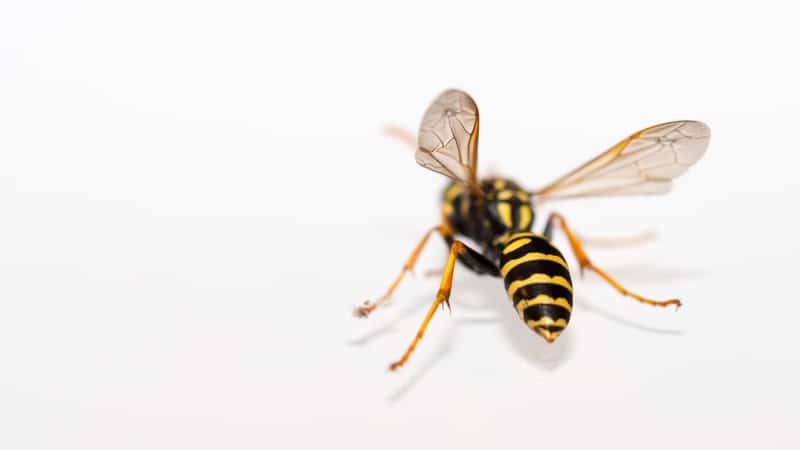
Fact: When Yellowjackets hunt for food, they hovering back and forth from their nest and usually eat sweets and meat.
In terms of stinging, they can be a pain. However, they are usually non-violent except when bothered. They become quite aggressive when defending their nests.
2. Hornets
One of our favorite southern sayings is “he was mad as a hornet.” This comes from the fact that these wasps can be very temperamental.
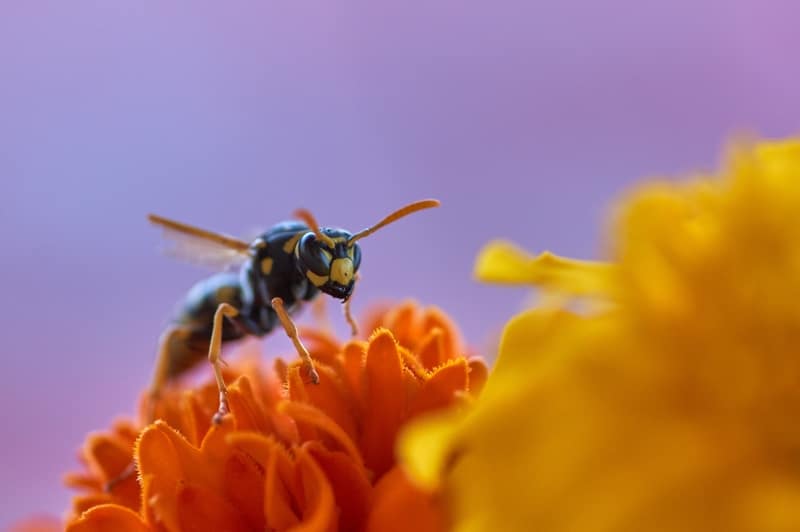
Hornets measure two inches and construct large paper-like nests made from chewed wood. They are also referred to as bald-faced hornets and have a similarity to yellowjackets in terms of color but differ in size.
They nest in wooded spaces, bushes, tree branches, sides of buildings or houses, and poles. In a Hornet nest, there are only up to seven hundred members.
3. Paper Wasps
Paper Wasps create distinctive, umbrella-shaped water-resistant nests out of gray or brown paper material. Their nest doesn’t have an external cover but houses around 25 wasps, though the number may grow to over 100.
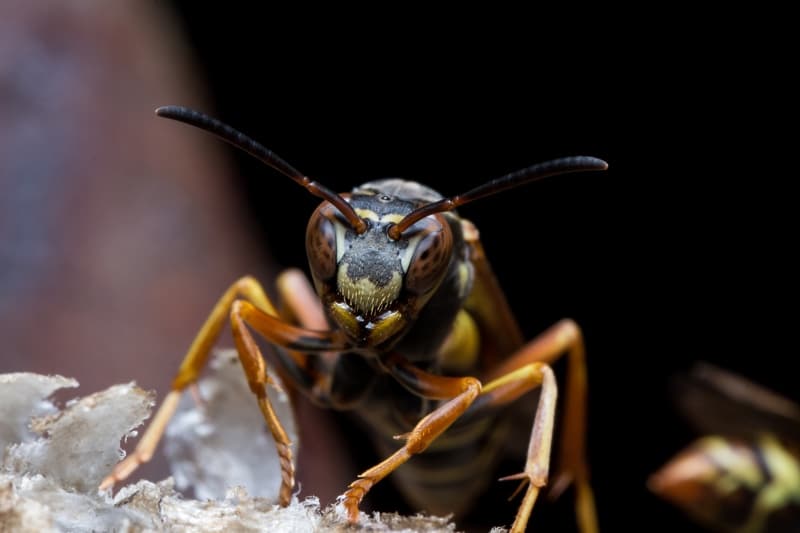
In terms of appearance, they are longer and slimmer than yellowjackets. They also show more color variations, as there are multiple species of Paper Wasps.
Solitary Wasps
Unlike Social Wasps, Solitary Wasps live alone and don’t create big colonies. They usually flock during midsummer. To add, they are hunters and prey on crickets, cicadas, spiders, and other insects. They weaken their prey and carry it to a den.
After that, they lay an egg to their prey and the larva feeds it. Usually, they are not hostile and their stings don’t hurt. The following is a list of common types of solitary wasps.
4. Cicada Killer Wasps
Considered the main wasp species in Nebraska, Cicada Killer Wasps are about one and a half to two inches in size and have black and yellow stripes.
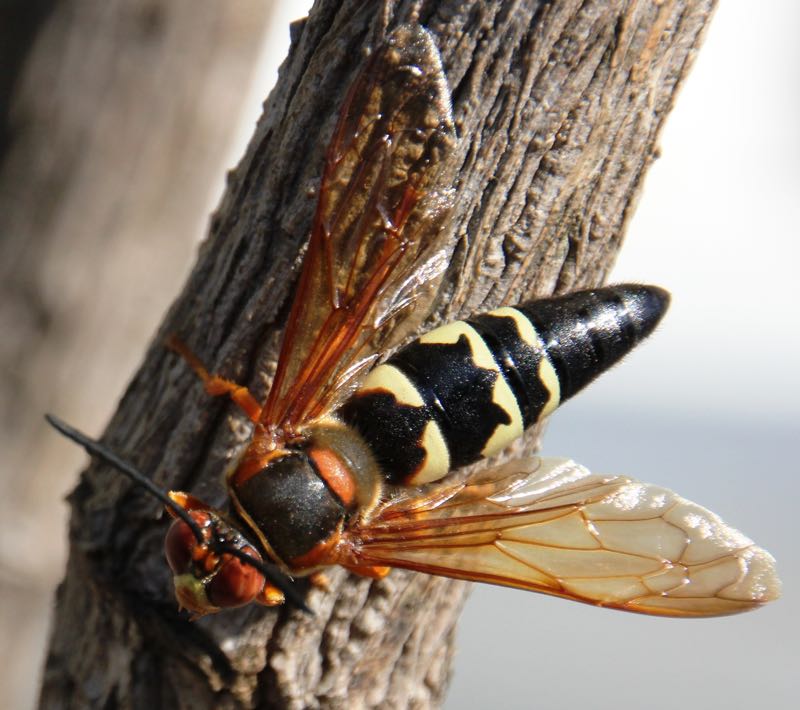
The holes they create underground are near trails, driveways, and walls. These wasps have the capacity to build nests wherever they like.
They actually get their names from the fact that they have a sophisticated way of killing their prey (cicada, grasshoppers, and crickets) using paralyzing venom.
Not to worry though. These wasps usually don’t waste their hunting time on humans.
5. Tarantula Hawk Wasp
The Spider Hawk Wasp is a huge, dark blue wasp that has glossy brown-orange wings, somewhat tinier than a cicada killer.
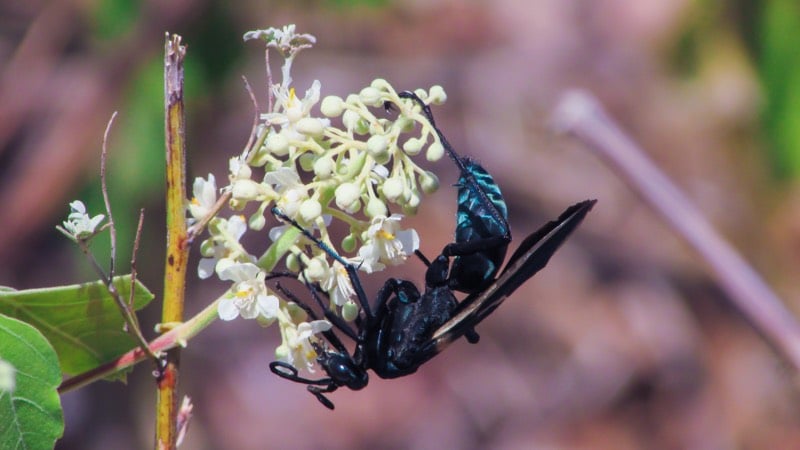
A distinguishing feature is the curled female’s antennae. Spider Hawks have the same performance but as can be guessed by their name, favor spiders as food for their larvae.
They have one of the most painful stings in the insect world, but they are not as widespread as other wasps, being found mostly in and around deserts.
6. Steel Blue Cricket Hunters
Another large wasp that can reach one inch in length, the Steel Blue Cricket Hunter is also called Thread-waist Wasp or Aphid Wasp.
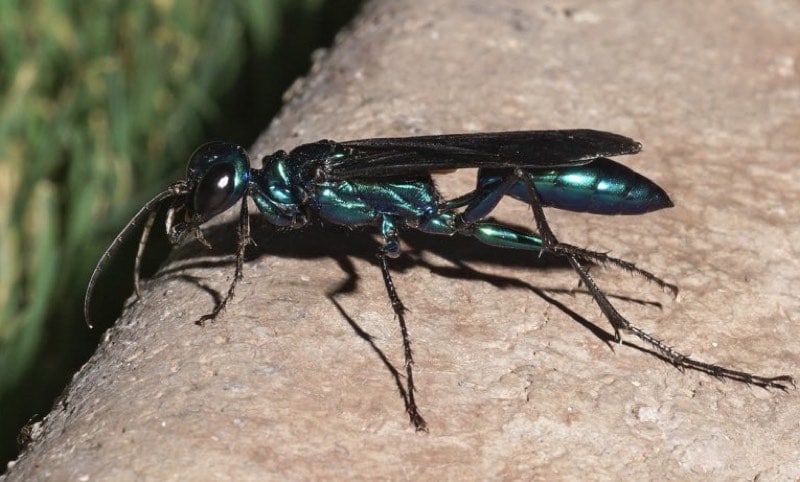
Up close, you can see that their body is a dark steel blue metallic color with dusky wings. As implied in their name, their larvae are nourished mainly by crickets.
7. Sand Wasps
The Sand Wasp is an inch long, has huge eyes, and has a black and white striped body. Despite the fact of being a Solitary Wasp, some females group as one to make separate nests in the soil and dishearten attackers.
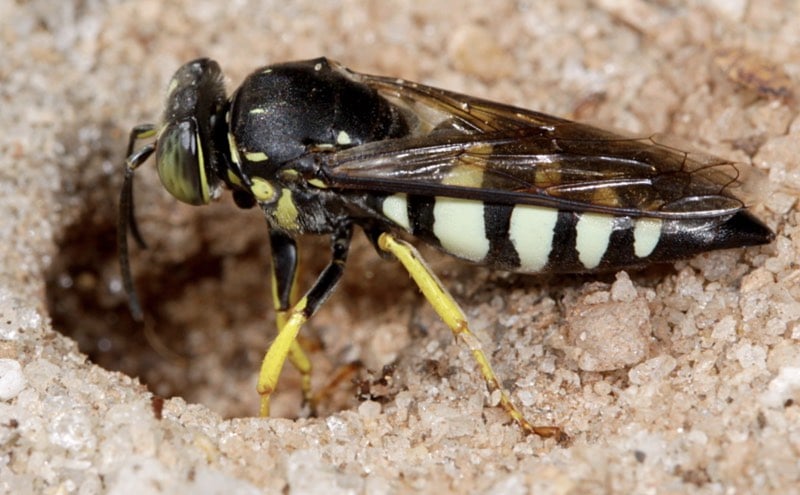
Sandboxes in backyards are sand wasps’ target for feeding their larvae primarily with flies. So if you have children and see wasps in their sandy play areas, tell them to be careful.
8. Mud Wasps
Considered the “lone wolf” of the wasp species, Mud Wasps build their colonies on their own and attack only to catch their prey.
These wasps can be Mud Daubers, Potter Wasps, and Pollen Wasps. As their name suggests, they create nests both above and in the ground.
Mud Daubers
Mud Daubers are long, slender wasps about an inch long. Their nests are small with tube-shaped or cylindrical structures with a colony of three to twenty wasps.
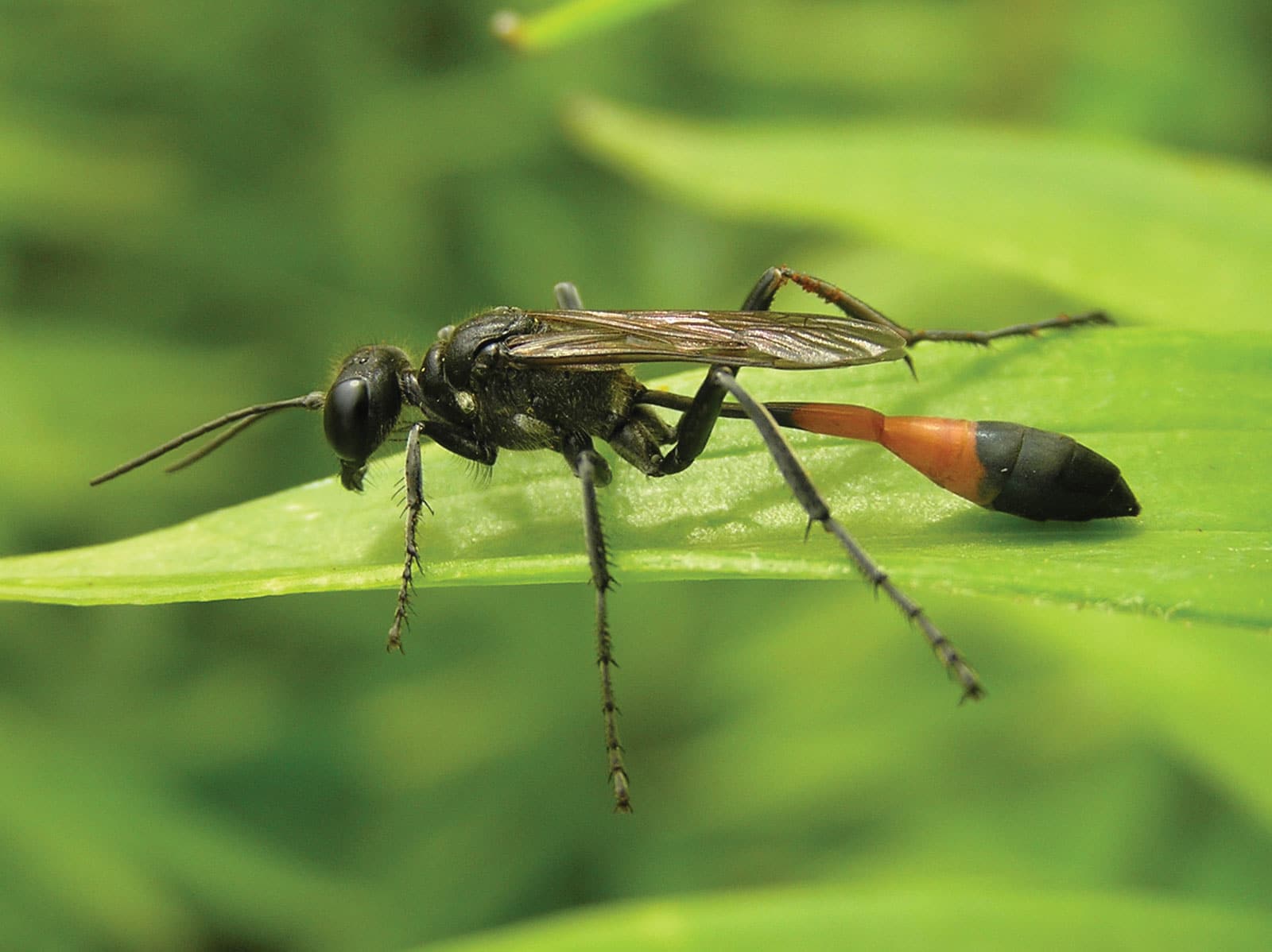
They can sting even when not provoked and do not defend their nests much like the Yellowjackets.
They can be found under porches, in attics, eaves, and walls. But rest assured: they usually prey on spiders, specifically black widows.
Potter Wasps
These are tiny wasps at about half an inch in size. They are called like that because of the jug or pot shape of their nests.
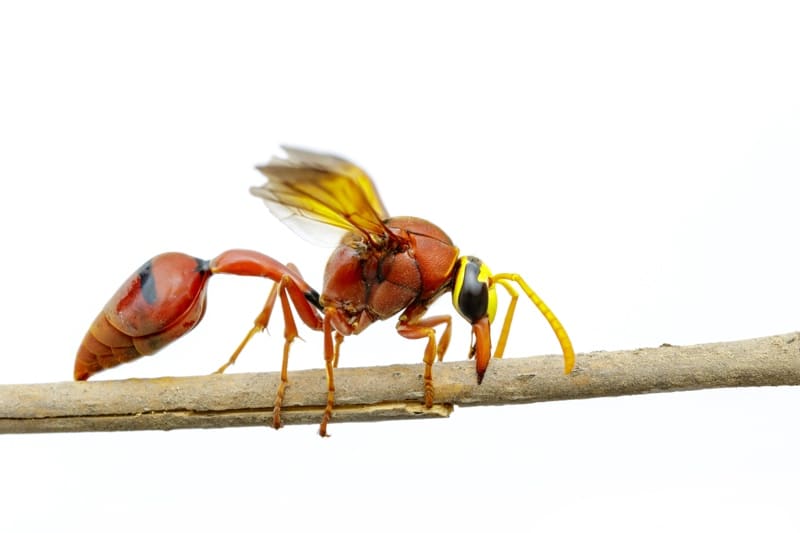
Among all the other wasp species, Potter Wasps enjoy the largest diversity: scientists have counter over 200 varieties.
Pollen Wasps
Pollen Wasps are occasionally mistaken for yellow jackets because they are so small (about 0.25 to 1 mm long.) But Pollen Wasps have huge antennas, their distinguishing feature.
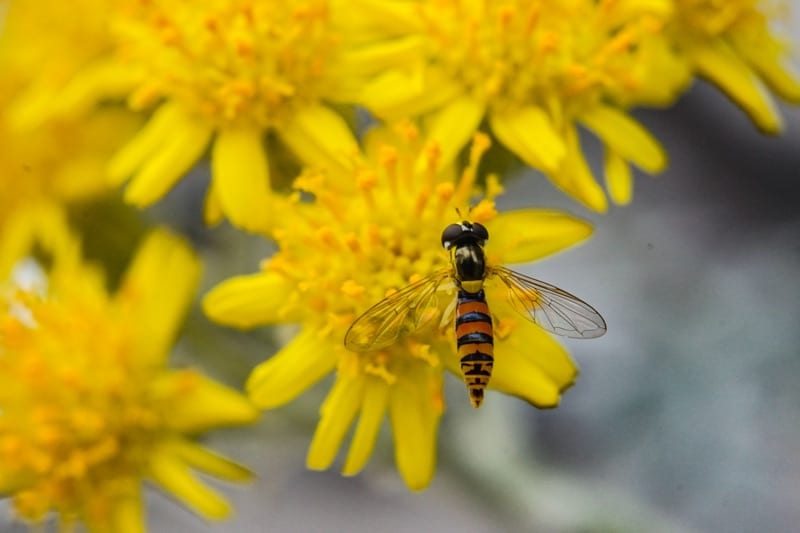
They create their nests underground in the mud and water. Can you guess from their name what they like to feed on?
Our Readers’ Bee Questions Answered
Do you have some unanswered questions in your mind? Here are some of the most frequently asked questions about bees with answers.
What are the 3 types of bees?
In a honeybee colony, there are three types of bees: workers, drones, and a queen. Thousands of worker bees work together in building a nest, gathering food, and nurturing offspring while the queen and drones mate to produce offspring.
How do I identify a Honey Bee?
To distinguish a Honey Bee from other types of bees, keep in mind that they are not furry or hairy like Bumble Bees and they are also smaller and have longer but slimmer figures. Another thing you can observe is their flight path since they travel between flowers.
Will bees sting you for no reason?
Most bees will only sting when they feel threatened or bothered. They sting to defend their hive and normally only attack in their defense. The only exception is Killer Bees, who may easily attack people.
How do I know what kind of bees I have?
Honey Bees are smaller than Bumble Bees and less hairy. Mason bees can be even smaller. But there are many other varieties around, so check out now our list of the different types of bees you may encounter.
What’s Your Favorite Type of Bee?
To sum up, every type of bee or wasp is important for the environment. Knowing and understanding each kind can help us help bees survive: or just not get in their way.
Some bees are more widespread and social than others, it’s true, but all types of bees are interesting in their own way. Whether you’re a bee expert, dreaming about bees, or are just exploring the wonderful world of bees, we’d love to hear from you.
Is there a specific type of bee you like? Why? And what’s the most common bee in your area?

I have a bee named B.B. ( short for bebyena ) A.K.A the BB gun. And I found him a day ago, we don’t know what type of bee he is but we think it’s one of those stingless bees because he doesn’t sting or bite, and he’s a boy.
I am trying to determine what kind of bee is hanging out around my porch. I know I have carpenter bees, because I have the holes everywhere and they tend to hang out with me on a daily basis. The bee I am curious about is a bit longer and slimmer than the carpenter bee, with a more pointed tail, although just about the same size. They are also using some of the holes made from the carpenter bees. The carpenter bees don’t worry me, I actually enjoy watching the destruction they are causing in my wood…lol. But I’m not sure about these other fellas!?!
Hey! Thanks for your comment. Could it be a honeybee? They are a little bit slimmer!
I saved a honey bee from being eaten by a fish on a hot sunny afternoon. As I sat on the edge of the lake I watched the little bee fighting for its life in a lake full of fish. I gently put of small stick into the water and lifted it out. Slowly it began to move as it dried it wings. Then it lifted itself into the air. Silly as it may seem, that one bee mattered.
Hey Elisabeth! That is such a cool story and I totally agree, all the bees matter! Even more so now. Thank you for this. Jiri